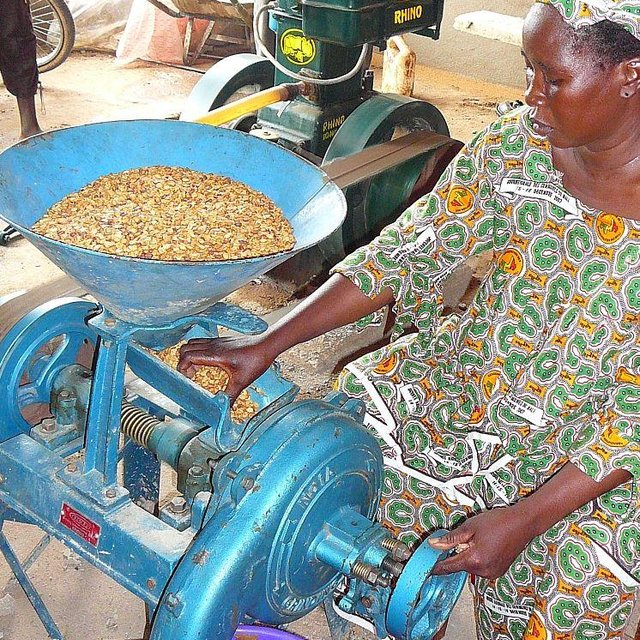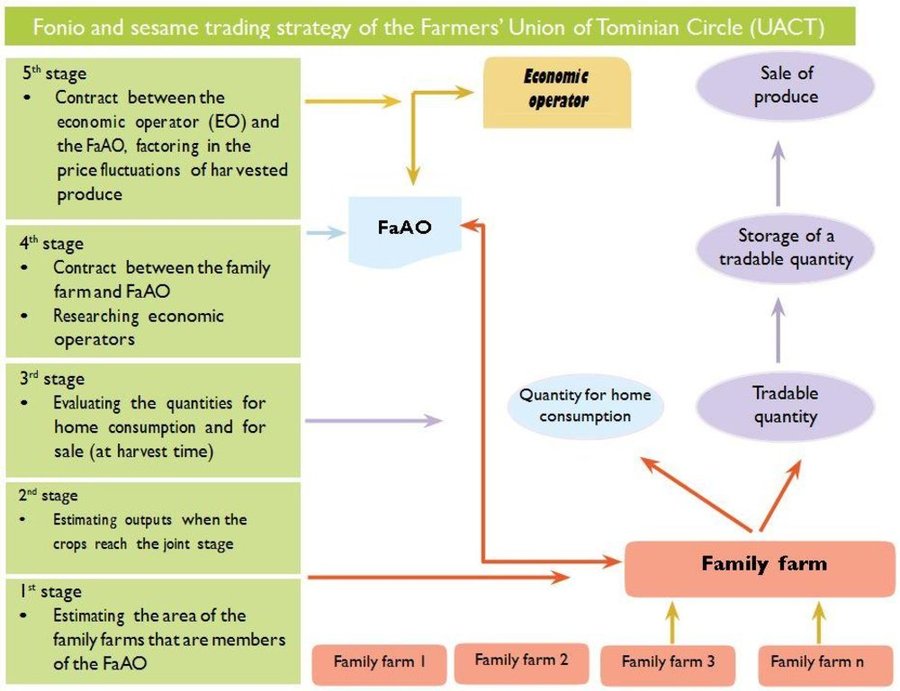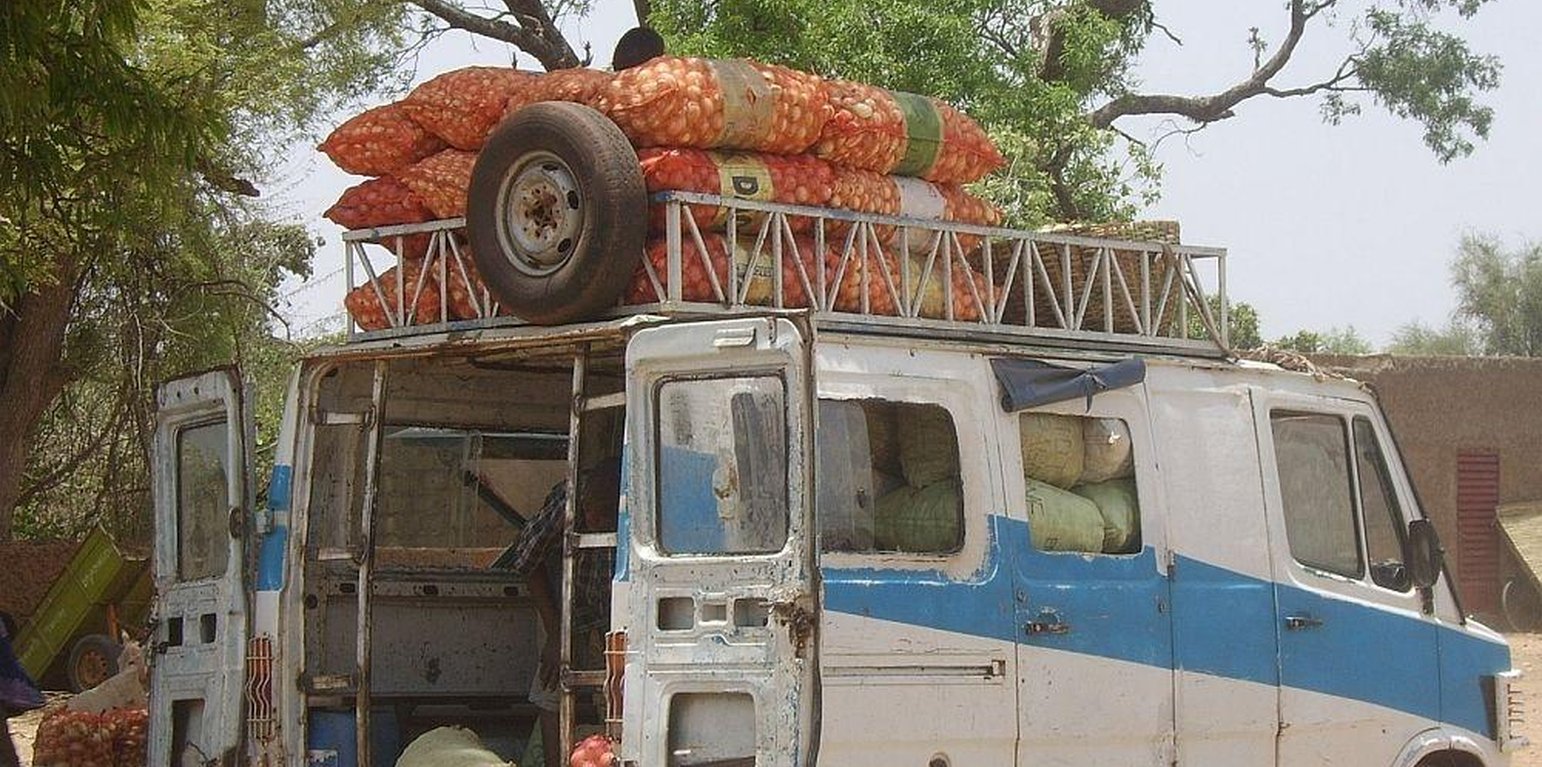Bulk sales approach for farmer apex organisations (FaAO)
(مالي)
Approche de commercialisation groupée par des organisations paysannes faitières (OPF))
الوصف
Improve the income of family farms by setting up an organized trade mechanism that factors in market price fluctuations.
The objective of the practice is to improve the income of family farms by setting up an organized trade mechanism that factors in market price fluctuations. Structuring trade in this way puts producers in a stronger position in their value chains.
The FaAOs’ approach to trade is based, on the one hand, on purchase agreements for preservable produce (cereals, sesame, etc.) between the FaAO and its producers and, on the other, on sales contracts with one or several market operators/suppliers. The practice enables producers to sell their produce after the harvest at an attractive price, depending on market fluctuations. For the operator, it means a large quantity can be purchased over time, without the need for mobilising major pre-financing resources. As the intermediary, the FaAO benefits from a profit margin and charges levied on transactions.
Stages of implementation: 1) Estimating the areas of family farms that are members of the FaAO: Together with its producers, the FaAO calculates sown areas (of rice, for example) fairly speculatively, providing the first estimates of future outputs. 2) Estimating outputs: Prior to harvesting, the initial estimates made in stage 1 are further refined through crop inspections. 3) Evaluating the quantities for home consumption and for sale: After the harvest, FaAO producers assess what part of their output will be retained for home consumption and what will be sold. 4) Contracting between the family farms and FaAO: The FaAO enters into a contract with the producers for the part to be sold. 5) Contracting between the economic operator and FaAO: Research into economic operators; At a consultation day involving producers, FaAO and operators, a contract is negotiated between FaAO and the operators, who will factor in price increases up to the lean period. Operation: Introducing this approach requires a robust FaAO or family farm, a market analysis and good quality produce. The portion of the output for sale is transferred to the FaAO storage facility. The operator draws down this produce over an extended period. The price for each consignment varies according to the market rate prevailing at the time the produce is drawn down.
Producers provide, process and pack the produce, and enter into a contract with FaAO. The apex organisation researches economic operators, negotiates the sales contract on behalf of the economic operators, stores the produce, monitors sales and manages rebates. Operators draw down produce in line with the terms of the sales contract, and make payments accordingly. Support partners deliver training, provide advisory support and foster contacts.
الموقع
![]()
الموقع: Ségou, Sikasso, Mali, مالي
المرجع الجغرافي للمواقع المختارة
تاريخ البدء: 2008
سنة الإنهاء: غير متاح
نوع النهج
-
تقليدي/أصلي
-
مبادرة محلية حديثة/مبتكرة
-
قائم على مشروع/برنامج

Hulling fonio in San (HELVETAS Swiss Intercooperation)
غايات النهج والبيئة المواتية
الغايات/الأهداف الرئيسية للنهج
The objective of the practice is to improve the income of family farms by setting up an organized trade mechanism that factors in market price fluctuations. Structuring trade in this way puts producers in a stronger position in their value chains.
The SLM Approach addressed the following problems: low income of family farms, market price fluctuations
الشروط التي تمكن من تنفيذ التقنية/التقنيات المطبقة في إطار النهج
الظروف التي تعيق تنفيذ التقنية/التقنيات المطبقة في إطار النهج
-
توفر/الوصول إلى الموارد والخدمات المالية: low income of family farms
Treatment through the SLM Approach: setting up an organized trade mechanism that factors in market price fluctuations; purchase agreements for preservable produce (cereals, sesame, etc.) between the FaAO and its producers and sales contracts with one or several market operators/suppliers.
مشاركة وأدوار الأطراف المعنية
الأطراف المعنية بالنهج وأدوارها
| ما هي الجهات المعنية / الكيانات المنفذة التي شاركت في النهج؟ |
حدد الأطراف المعنيين |
وصف أدوار الأطراف المعنية |
| مستخدمو الأراضي المحليون/المجتمعات المحلية |
|
|
| متخصصون في الإدارة المستدامة للأراضي / مستشارون زراعيون |
|
|
| منظمة غير حكومية |
|
|
| الحكومة المحلية |
|
|
| الحكومة الوطنية (المخططون، صانعو القرار) |
|
|
انخراط مستخدمي الأراضي المحليين/المجتمعات المحلية في المراحل المختلفة للنهج
غير موجود
سلبي
الدعم الخارجي
تفاعلي
التعبئة الذاتية
مخطط التدفق
The stages of the trading strategy

المؤلف: HELVETAS Swiss Intercooperation
اتخاذ القرار بشأن اختيار تقنية الإدارة المستدامة للأراضي
وقد تم اتخاذ القرارات من قبل
-
مستخدمو الأراضي وحدهم (المبادرة الذاتية)
-
مستخدمو الأراضي بشكل أساسي، بدعم من متخصصي الإدارة المستدامة للأراضي
-
جميع الجهات الفاعلة ذات الصلة، كجزء من نهج تشاركي
-
متخصصون في الإدارة المستدامة للأراضي بشكل أساسي، بعد التشاور مع مستخدمي الأراضي
-
متخصصون في الإدارة المستدامة للأراضي بمفردهم
-
السياسيون / القادة
تم اتخاذ القرارات بناء على
-
تقييم المعرفة الموثقة جيدًا بشأن الإدارة المستدامة للأراضي(اتخاذ القرارات القائمة على الأدلة)
-
نتائج البحوث
-
خبرة وآراء شخصية(غير موثقة)
الدعم الفني وبناء القدرات وإدارة المعرفة
شكلت الأنشطة أو الخدمات التالية جزءًا من النهج
-
بناء القدرات/التدريب
-
خدمة استشارية
-
تعزيز المؤسسات (التطوير التنظيمي)
-
الرصد والتقييم
-
البحوث
بناء القدرات/التدريب
تم تقديم التدريب للأطراف المعنية التالية
-
مستخدمو الأراضي
-
موظفون ميدانيون/ مستشارون
شكل التدريب
-
في العمل
-
من مزارع إلى مزارع
-
مناطق العرض
-
اجتماعات عامة
-
دورات
المواضيع المغطاة
Support partners deliver training, provide advisory support and foster contacts.
تعزيز المؤسسات
تم تعزيز/إنشاء المؤسسات
-
لا
-
نعم، قليلا
-
نعم، باعتدال
-
نعم، إلى حد كبير
صف المؤسسة والأدوار والمسؤوليات والأعضاء وما إلى ذلك.
نوع الدعم
-
مالي
-
بناء القدرات/التدريب
-
معدات
مزيد من التفاصيل
Improve the income of family farms by setting up an organized trade mechanism that factors in market price fluctuations. Structuring trade in this way puts producers in a stronger position in their value chains.
الرصد والتقييم
socio-cultural aspects were ad hoc monitored by project staff, land users through observations
economic / production aspects were regular monitored by project staff through measurements
management of Approach aspects were ad hoc monitored by project staff through observations
There were no changes in the Approach as a result of monitoring and evaluation
There were no changes in the Technology as a result of monitoring and evaluation
البحوث
تناول البحث المواضيع التالية
-
علم الاجتماع
-
الاقتصاد / التسويق
-
علم الايكولوجيا
-
تكنولوجيا
التمويل والدعم المادي الخارجي
الميزانية السنوية بالدولار الأمريكي لمكون الإدارة المستدامة للأراضي
-
< 2000
-
10,0000-2,000
-
100,000-10,000
-
1,000000-100،000
-
> 1,000,000
Precise annual budget: غير متاح
Approach costs were met by the following donors: international non-government: 100.0%
تم تقديم الخدمات أو الحوافز التالية لمستخدمي الأراضي
-
الدعم المالي/المادي المقدم لمستخدمي الأراضي
-
إعانات لمدخلات محددة
-
الائتمان
-
حوافز أو وسائل أخرى
تحليل الأثر والتصريحات الختامية
آثار النهج
لا
نعم، قليلا
نعم، باعتدال
نعم، إلى حد كبير
هل ساعد النهج مستخدمي الأراضي على تنفيذ وصيانة تقنيات الإدارة المستدامة للأراضي؟
The approach offers producers greater opportunities to access enhanced seeds and inputs (credibility among service providers).
هل ساهم النهج في تمكين الفئات المحرومة اجتماعيا واقتصاديا؟
When prices become more lucrative, producers are less inclined to sell off their harvest; the risk of slumps in prices is minimal.
Did other land users / projects adopt the Approach?
Implementation locations: Ségou and Sikasso. 12,750 beneficiaries are applying this approach in 14 apex organisations.
المحفز الرئيسي لقيام مستخدمي الأراضي بتنفيذ الإدارة المستدامة للأراضي
-
زيادة الإنتاج
-
زيادة الربح (القدرة)، وتحسين نسبة التكلفة إلى العائد
-
الحد من تدهور الأراضي
-
الحد من مخاطر الكوارث
-
انخفاض عبء العمل
-
المدفوعات/ الإعانات
-
القواعد واللوائح (الغرامات) / الإنفاذ
-
الوجاهة والضغط الاجتماعي/التماسك الاجتماعي
-
الانتماء إلى حركة/ مشروع/ مجموعة/ شبكات
-
الوعي البيئي
-
العادات والمعتقدات والأخلاق
-
تعزيز المعرفة والمهارات في مجال الإدارة المستدامة للأراضي
-
تحسينات جماليية
-
التخفيف من حدة الصراع
استدامة أنشطة النهج
هل يمكن لمستخدمي الأراضي الحفاظ على استدامة ما تم تنفيذه من خلال النهج (بدون دعم خارجي)؟
الاستنتاجات والدروس المستفادة
نقاط القوة: وجهة نظر مستخدم الأرض
نقاط القوة: وجهة نظر جامع المعلومات أو غيره من الأشخاص الرئيسيين لمصدر المعلومات
-
Bank loans guaranteed as a result of retained stocks and management tools
-
Guaranteed revenues for small-scale producers
-
Improved post-harvest management
-
As revenues grow, producers seek to maximise their cropping schedules in order to earn more money. The approach offers producers greater opportunities to access enhanced seeds and inputs (credibility among service providers). When prices become more lucrative, producers are less inclined to sell off their harvest; the risk of slumps in prices is minimal. Incomes are stabilised, which improves living conditions and social cohesion. Communities are better able to pay taxes and more receptive to formalised contracts.
-
Price stabilisation (to prevent produce from being sold-off) and improved producer incomes (How to sustain/ enhance this strength: A thorough market analysis must be conducted to enable market price fluctuations to be accurately predicted and the best times for sale to be pinpointed. Client relationships must be professional and contractual. Informal commitments often fall through. The FaAO must have committed and business-minded leaders. It is wise to stay vigilant when it comes to the governance of these organisations, as they can fall prey to corrupt practices and the embezzlement of collective funds.)
نقاط الضعف / المساوىء / المخاطر: وجهة نظر مستخدم الأرضكيفية التغلب عليها
نقاط الضعف / المساوىء / المخاطر: وجهة نظر جامع المعلومات أو غيره من الأشخاص الرئيسيين لمصدر المعلوماتكيفية التغلب عليها
المراجع
تاريخ التوثيق: 24 سبتمبر، 2014
اخر تحديث: 21 يونيو، 2017
الأشخاص الرئيسيين لمصدر المعلومات
-
Dieter Nill (dieter.nill@giz.de) - متخصص في الإدارة المستدامة للأراضي
-
Maïga Rosaline Dacko (rosaline.dacko@helvetas.org) - متخصص في الإدارة المستدامة للأراضي
-
Lassana Keita (lassana.keita@helvetas.org) - متخصص في الإدارة المستدامة للأراضي
-
Idrissa Guindo (idrissa.guindo@helvetas.org) - متخصص في الإدارة المستدامة للأراضي
الوصف الكامل في قاعدة بيانات WOCAT
بيانات الإدارة المستدامة للأراضي المرتبطة
تم تسهيل التوثيق من قِبَل
المؤسسة
- Deutsche Gesellschaft für Internationale Zusammenarbeit (GIZ) GmbH (GIZ) - ألمانيا
- HELVETAS (Swiss Intercooperation)
المشروع
المراجع الرئيسية
-
Manual of Good Practices in Small Scale Irrigation in the Sahel. Experiences from Mali. Published by GIZ in 2014.: http://star-www.giz.de/starweb/giz/pub/servlet.starweb
-
HELVETAS Swiss Intercooperation: annual report 2010-2011 for the San Hub (Pôle de San) :
-
HELVETAS Swiss Intercooperation (2013): JIGIYA programme evaluation report:





